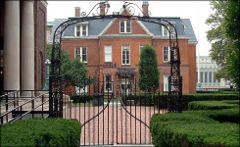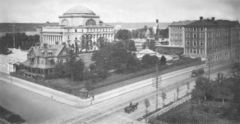Difference between revisions of "Buell Hall"
Absentminded (talk | contribs) |
|||
| Line 3: | Line 3: | ||
'''Buell Hall''' (also known in the past as "College Hall", "Alumni House" and "East Hall"), is the only remaining building on the [[Morningside Heights campus]] that dates back to Columbia's predecessor on the site, the [[Bloomingdale Insane Asylum]]. Today Buell is better known as "[[Maison Française]]" as the French cultural house is the primary occupant of the building, though it shares the building with gallery space for [[GSAPP]] and GSAPP's [http://www.arch.columbia.edu/Buell/ Temple Hoyne Buell Center for the Study of American Architecture], which strangely has its office in [[Avery Hall|Avery]] anyway. | '''Buell Hall''' (also known in the past as "College Hall", "Alumni House" and "East Hall"), is the only remaining building on the [[Morningside Heights campus]] that dates back to Columbia's predecessor on the site, the [[Bloomingdale Insane Asylum]]. Today Buell is better known as "[[Maison Française]]" as the French cultural house is the primary occupant of the building, though it shares the building with gallery space for [[GSAPP]] and GSAPP's [http://www.arch.columbia.edu/Buell/ Temple Hoyne Buell Center for the Study of American Architecture], which strangely has its office in [[Avery Hall|Avery]] anyway. | ||
| − | Designed in [[1885] and built with a gift from William H. Macy, Macy Villa, as it was originally called, was a residential facility for wealthy male insane people, so that they wouldn't have to mix with the hoi polloi in the more "institutional" main buildings. In the spring of [[1895]], Columbia's [[Crew]] team took possession of the Villa for their use.<ref>[http://query.nytimes.com/gst/abstract.html?res=9A0DE7DB103AE533A25756C2A9659C94649ED7CF COLUMBIA'S IMPROVED CREW.; Has Moved Into Macy Cottage and Is Doing Good Work.], New York Times, March 25, 1895</ref> | + | Designed in [[1885]] and built with a gift from William H. Macy, Macy Villa, as it was originally called, was a residential facility for wealthy male insane people, so that they wouldn't have to mix with the hoi polloi in the more "institutional" main buildings. In the spring of [[1895]], Columbia's [[Crew]] team took possession of the Villa for their use.<ref>[http://query.nytimes.com/gst/abstract.html?res=9A0DE7DB103AE533A25756C2A9659C94649ED7CF COLUMBIA'S IMPROVED CREW.; Has Moved Into Macy Cottage and Is Doing Good Work.], New York Times, March 25, 1895</ref> |
| − | Prior to the construction of [[Kent Hall]], Buell actually sat on 116th street. It was physically moved back to make way for the new building, and in the process, the deep wooden porches that had surrounded the building were removed. Until 1964, Buell Hall housed offices of the [[School of General Studies]]. | + | Prior to the construction of [[Kent Hall]], Buell actually sat on 116th street. It was physically moved back to make way for the new building, and in the process, the deep wooden porches that had surrounded the building were removed. Until [[1964]], Buell Hall housed offices of the [[School of General Studies]]. |
<gallery> | <gallery> | ||
Revision as of 17:54, 14 December 2007
Buell Hall (also known in the past as "College Hall", "Alumni House" and "East Hall"), is the only remaining building on the Morningside Heights campus that dates back to Columbia's predecessor on the site, the Bloomingdale Insane Asylum. Today Buell is better known as "Maison Française" as the French cultural house is the primary occupant of the building, though it shares the building with gallery space for GSAPP and GSAPP's Temple Hoyne Buell Center for the Study of American Architecture, which strangely has its office in Avery anyway.
Designed in 1885 and built with a gift from William H. Macy, Macy Villa, as it was originally called, was a residential facility for wealthy male insane people, so that they wouldn't have to mix with the hoi polloi in the more "institutional" main buildings. In the spring of 1895, Columbia's Crew team took possession of the Villa for their use.[1]
Prior to the construction of Kent Hall, Buell actually sat on 116th street. It was physically moved back to make way for the new building, and in the process, the deep wooden porches that had surrounded the building were removed. Until 1964, Buell Hall housed offices of the School of General Studies.
Entrance to Buell while it housed GS
References
- ↑ COLUMBIA'S IMPROVED CREW.; Has Moved Into Macy Cottage and Is Doing Good Work., New York Times, March 25, 1895



